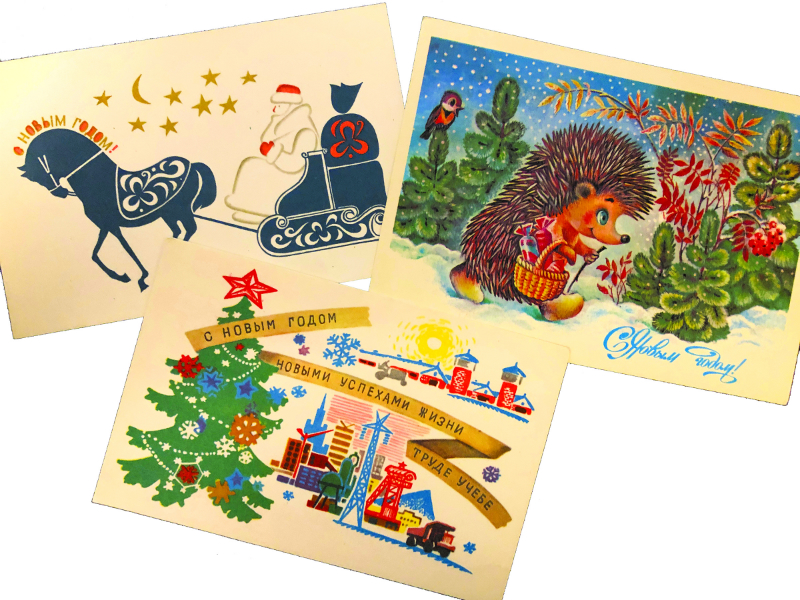Growing up in Edmonton in the 1980s, Christmas was something I glimpsed through neighbours’ windows and delicately danced around when asked by kindly shop clerks what I wanted from Santa. Occasionally, though, Christmas arrived in the mail, on postcards covered in cheery, ornament-laden trees. Why were my grandparents sending us Christmas greetings from the U.S.S.R., the country where I was born?
They weren’t, it turned out. The accompanying greeting always read “S’novom Godom” – Happy New Year.
Religion was verboten in the Soviet Union and, from early on, Dec. 25 was a regular workday. By 1935, it was clear that the people needed cheer – spiritual fortification against famines and purges. So, out with the old and in with the … old? Framed as a tradition for children, tied to happiness and prosperity, Soviet New Year had all the trappings of Christmas, minus the baby Jesus.
That meant a yolka, the New Year’s tree, Dyed Moroz (Grandfather Frost) and Sneguroshka (Snow Maiden, Frost’s granddaughter), taken straight out of old Slavic mythology. Every family had its decorating rituals and ornaments and the most special and difficult-to-acquire foods were always served. Public celebrations for children were often tied to traditional Russian fairytales and characters.
New Year’s was especially loved for its emphasis on festive gatherings and lack of ideological ties, unlike the rest of the holiday calendar. It was an easy holiday for Jews to accept, regardless of their feelings towards the state.
For the rest of the world, after the crucifix, there is little that’s more deeply representative of everything not Jewish than a Christmas tree. What a surprise for Soviet-Jewish immigrants to discover that their most treasured childhood memories were not only religious, but the wrong religion. Jewishness as a religion was a foreign concept to Soviet Jews, for whom it was an ethnicity.
When I ask my parents about yolkas, they send detailed descriptions of childhood tree-decorating rituals and celebrations. “Life in the U.S.S.R. was bleak, especially in the ’50s. The yolka was a source of joy,” explained my father. But he also hearkened back to the shtetl days, when “a little pogrom” was often part of the holiday fun. Once he learned about Christmas trees, these old, whispered lessons came to the fore.
So I grew up completely unaware of yolkas. We also happened to land in Edmonton, one of a small handful of Soviet-Jewish families in an already small and insular community. The only bit of Slavic to be found dated to pre-revolutionary Ukrainian immigration, which followed the Ukrainian Orthodox Church. Buying a yolka meant traipsing to Christmas tree lots. The Christian associations couldn’t be ignored.
Most importantly, there was no going back. The Soviet Union was locked behind us, so my parents had to look forward. Raising Jewish-Canadian children meant abandoning Soviet traditions. Families that arrived post-collapse, especially in neighbourhoods with larger Russian-Jewish communities, had a different experience acclimating and often different feelings towards their now open-bordered homeland.
The yolka has become controversial in a community that has maintained its distinct sense of identity, heritage and language. We can top our pelmeni (meat-filled dumplings) with sour cream and put out a multi-course spread for Novy God (New Year’s). But a yolka? Hmm.
According to the 2018 Survey of Jews in Canada, 14 per cent of Canadian Jews report having a Christmas or New Year’s tree – 36 per cent of that number is attributed to Jews from the former Soviet Union. The study, unfortunately, did not distinguish between Christmas and New Year’s, further propagating misinformation about yolkas.
Though the symbols are the same, yolkas are typically put up after Christmas. Jewish families that have them do not celebrate Christmas, which is notably different than interfaith families who do celebrate the holiday. Nearly every Russian Jew I know – in Canada and the U.S. – who has one, observes Jewish holidays, participates in Jewish life and most of them keep kosher. A not-so-scientific poll of my Russian-Jewish friends yielded responses from a resounding “Nyet,” to “I restarted after my kids were born,” to “We never stopped; I love it.”
It may seem straightforward – in the new country, trees mean Christmas, full-stop. And for many Russian Jews, the discussion ends there. The tradition was created by a government that sought to stamp us out of existence (while forever stamping our internal passports with the chains of that existence). It doesn’t fit our North American lives. But for others, it taps into fundamental questions about what kind of Jews we are.
Is there truly only one way to be Jewish? The answer, of course, is that for every two Jews, there are at least three ways to be Jewish. Yet, when it comes to Russian Jews, it feels like all the answers are that we’re wrong.
Russian Jews often feel rejected by a community, which insists on placing “Jews” and “Soviet Jews” into separate categories. So who do we become if we abandon the lives of those who came before us?
Someone I follow on Twitter recently posted images of her family’s yolka decorations. I looked at it and thought: how do you tell someone their entire life has been wrong; that the brightest spot in their year is the deepest of transgressions?
Russian Jews who have a yolka do so because it reminds them of their childhood, pays tribute to previous generations and brings familiar, festive cheer into their homes. There’s a limit to what we can reject of our parents’ and grandparents’ (or great-grandparents’) lives. After all, they all suffered “authentically” as Jews.
Their traditions and celebrations were just as Jewish – and for once, they came packaged with happy memories.
